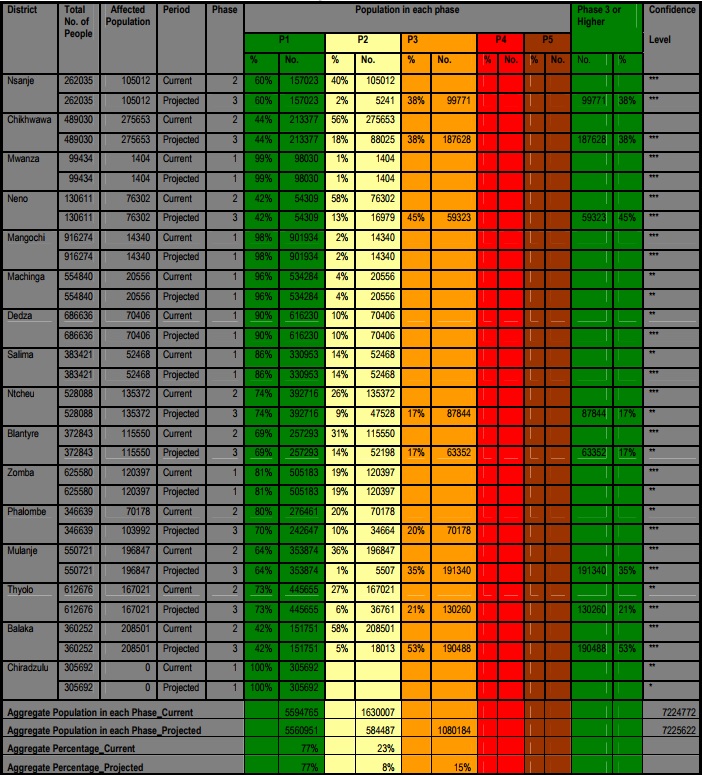01.07.2016
01.06.2012 > 30.09.2012
Map
Projected Map
Other Projections

Key
results
Population
estimates
Recommendations
& next steps
Acute
Malnutrition
Key outcomes for most affected areas
About 39 per cent of the total population in the Balaka, Blantyre, Chikhwawa, Mulanje, Neno, Nsanje, Ntcheu, Phalombe and Thyolo districts have food gaps ranging from 3 to 8 months in the 2012/13 consumption year.
Livelihood Change: “Poor” and some “Middle” Households will start using Stress coping mechanisms earlier than normal.
Nutritional status: While no nutritional survey was conducted recently, previous reports as of 2011 indicate Stress levels of food insecurity.
Mortality: Crude Death Rate (CDR) =0.5-1/10,000 persons/day indicating Crisis levels of food insecurity. According to Ministry of Agriculture and Food Security (MoAFS) third round crop production estimates this year, Malawi registered a 7% reduction in maize production as compared to last year. However, there was extremely low production especially for “Poor” and “Middle” Wealth Group Households for all key food and cash crops in the affected Districts. Significant reductions have also been registered in key cash crops such tobacco following the previous year’s bad market season which resulted in reductions in area planted.
Following the Nation-wide Cotton Up-scaling Programme, area planted for cotton increased by 322%. There was however a reduction of 59% for tobacco production because most farmers were disincentivized with the poor prices the crop fetched during the previous season. The Cotton Up-scaling Programme also had serious displacement effects for staples in some areas, especially maize which was the most substituted in favour of cotton. Despite the increase in area planted with cotton, per capita production among the “Poor” and “Middle” Households was very low as with other key cash and food crops due to unfavorable weather conditions. There was also poor adaptability of the cotton seed used in the Scale Up Programme.
Based on seasonality trends and low production coupled with the recent devaluation in the affected Districts, maize prices are much higher this season compared to the last consumption season. As of mid-June 2012, maize was already selling at an average of K45/kg compared to K25/kg same time last year. Both MVAC and FEWSNET project that maize prices will remain above the normal seasonal trends for the remainder of the consumption season.
Country Related Information
Contacts
- 01.07.2023 > 31.03.2024
Malawi: Acute Food Insecurity Situation for July - September 2023 and Projection for October 2023 - March 2024 - 20.05.2022 > 31.12.2026
Malawi: Chronic Food Insecurity Situation 2022 - 2026 - 01.11.2021 > 31.03.2022
Malawi: Acute Food Insecurity Situation November - December 2021 and January - March 2022 - 01.07.2021 > 31.03.2022
Malawi: Acute Food Insecurity Situation: July - September 2021 and Projection for October 2021 - March 2022 - 01.11.2020 > 31.03.2021
Malawi: Acute Food Insecurity Situation Update November - December 2020 and Projection for January - March 2021 - 01.07.2020 > 31.03.2021
Malawi: Acute Food Insecurity Situation July - September 2020 and Projection for October 2020 - March 2021 - 01.11.2019 > 31.03.2020
Malawi: Acute Food Insecurity Update of Projection November 2019 - March 2020 - 01.07.2019 > 31.03.2020
Malawi: Acute Food Insecurity July - September 2019 and Projection for October 2019 - March 2020 - 01.07.2018 > 31.03.2019
Malawi: Acute Food Insecurity Situation for July-September 2018 and projections for October 2018-March 2019 - 01.07.2017 > 31.03.2018
Malawi: Acute Food Insecurity Situation July-September 2017 and October 2017 - March 2018
- 02.07.2023 > 12.07.2023
Malawi: Acute Food Insecurity Analysis - 27.06.2022 > 02.07.2022
Malawi: Acute Food Insecurity Analysis - 14.02.2022 > 26.02.2022
Malawi: Chronic Food Insecurity Analysis - 24.11.2021 > 27.11.2021
MALAWI: Acute Food Insecurity Analysis
Join our mailing list


